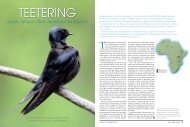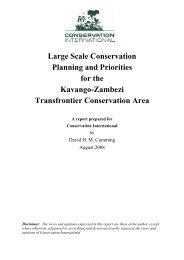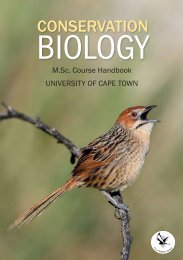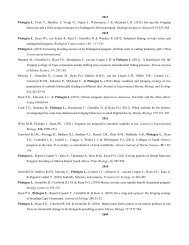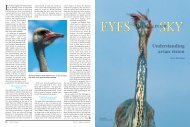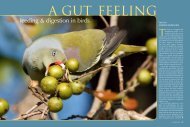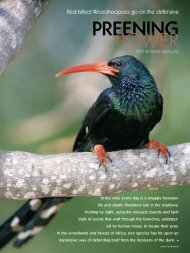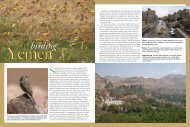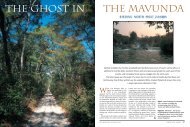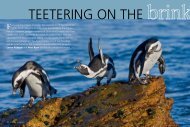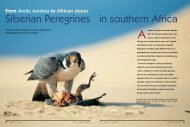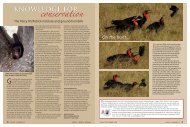Research Programmes & InitiativesDr Richard Deanserved as the Scientific Editor <strong>of</strong>Ostrich during 2001-2003 andas Editor and major contributingauthor <strong>of</strong> the Roberts VIIProject.During the review period heco-supervised one PhD studentand one MSc student. Heauthored or co-authored fourscientific publications andattended two scientific meetings.He also wrote many semipopulararticles in Karoonewspapers and hostednumerous talks and outings withKaroo residents and landownersto raise awareness <strong>of</strong> localenvironmental issues. Hereviewed five scientific paperssubmitted to two differentinternational journals. Dr Deanalso spent three months at theBritish Museum at Tring, Herts,UK, extracting details <strong>of</strong>southern <strong>African</strong> bird specimensfrom the collection.Land-use & BiodiversityProgramme leadersDr Richard DeanPr<strong>of</strong> Sue Milton (Conservation Ecology Department, University <strong>of</strong> Stellenbosch)Research TeamDr Nicki Allsopp (Agricultural Research Council, W Cape)Mark Anderson (Northern Cape Nature Conservation Services, Kimberley)Dr J. Aronson (CNRS, Montpellier, France)Dr Charles Boucher (Botany Department, University <strong>of</strong> Stellenbosch)Dr John Donaldson (National Botanical <strong>Institute</strong>, Kirstenbosch, Cape Town)Dr Karen Esler (Botany Department, University <strong>of</strong> Stellenbosch)Dr Florian Jeltsch (Department <strong>of</strong> Ecology, University <strong>of</strong> Potsdam, Germany)Dr Richard Knight (Botany Department, University <strong>of</strong> the Western Cape)Annalise le Roux (Western Cape Nature Conservation Board)Dr Melodie McGeoch (Conservation Ecology Department, University <strong>of</strong> Stellenbosch)Dr Guy Midgley (National Botanical <strong>Institute</strong>)Dr Peter Ryan (<strong>Percy</strong> <strong>FitzPatrick</strong> <strong>Institute</strong>, University <strong>of</strong> Cape Town)Dr Michael Schwartz (University <strong>of</strong> California at Davis, California, USA)Dr Jane Turpie (<strong>Percy</strong> <strong>FitzPatrick</strong> <strong>Institute</strong>, University <strong>of</strong> Cape Town)N Visser (Western Cape Department <strong>of</strong> Agriculture)Dr Thorsten Wiegand (Department <strong>of</strong> Ecological Modelling, UFZ, Leipzig, Germany)Pr<strong>of</strong>. Christian Wissel (Department <strong>of</strong> Ecological Modelling, UFZ, Leipzig, Germany)At present, two related ecological research initiatives fall loosely within thisprogramme:Functions, value, management and rehabilitation <strong>of</strong> biodiversity capital inthe Northern and Western Cape ProvincesOverviewCape biodiversity is rapidly being diminished by land transformation, alien plantinvasion and climate change. Ecologists <strong>of</strong>ten find it difficult to argue that biodiversityshould be conserved and rehabilitated to a near natural state following damage,largely because <strong>of</strong> the meagre scientific evidence to support the notion that diverseplant and animal communities are more valuable to South Africa than impoverishedones. A second difficulty is the need to advise on management to retain or restorebiodiversity in species-rich natural habitats or habitat fragments.The Western and Northern Cape Provinces house the species-rich endemic floras<strong>of</strong> the Cape Floral kingdom, namely the Fynbos, Renosterveld and Succulent Karoo.The amphibian, reptile and invertebrate faunas <strong>of</strong> these regions also include manyendemic genera and species. Little is known <strong>of</strong> the functional significance <strong>of</strong> Capebiodiversity in terms <strong>of</strong> maintaining soil fertility, stabilising biomass production underfluctuating weather conditions, or providing resistance to invasions <strong>of</strong> alien weeds.Recent research elsewhere indicates that diverse rangelands are more productiveand more resistant to weed invasion than species-poor communities. The servicesthat untransformed landscapes <strong>of</strong>fer to rural and urban people include water and airpurification, flood control, pollination, recreation, utility products (wood, flowers,medicines) and a reserve <strong>of</strong> genetic material for future development.The climate <strong>of</strong> these areas ranges from Mediterranean to arid, and climate changepredictions indicate further aridification within the next 50 years. The lowland areasare arable, and large areas <strong>of</strong> natural vegetation have been transformed for drylandagriculture. Recent development <strong>of</strong> irrigation infrastructure, <strong>of</strong> new agriculturalmarkets for grain, oil, wine and vegetables, and <strong>of</strong> open-cast mining enterprises mayLand-use & Biodiversity 23
PhD student Colleen Seymour is working on the role <strong>of</strong> Acaciaerioloba in preserving biodiversity in the Kalahari. Photo: OnnoHuyserthreaten remaining fragments <strong>of</strong> natural lowland vegetation inthe southwestern parts <strong>of</strong> the Western Cape. Arid savanna andKaroid areas within these provinces, that have no access toirrigation, are threatened by management designed to increasestocking densities for domestic livestock, and by an urbanmarket for firewood from indigenous hardwood Acacias.In general, this project aims to quantify rates and biodiversitycosts <strong>of</strong> natural habitat transformation, understand thefunctions and value <strong>of</strong> biodiversity in the region, and provideguidelines for sustaining and restoring biodiversity in utilizedand conserved rural and peri-urban Cape landscapes.Ultimately, the key outcomes <strong>of</strong> the project will be thedevelopment <strong>of</strong> (i) a theoretical framework for incentives andpolicy for biodiversity restoration based on an understanding <strong>of</strong>the influence <strong>of</strong> vegetation diversity on secondary production,faunal diversity and resistance to alien plant invasions, and (ii)recommendations for conservation management andrehabilitation <strong>of</strong> selected Cape vegetation types (particularlyRenosterveld, Strandveld and Succulent Karoo) based ontheoretical modelling, observation and experimentation.Karoo ecosystem responses to land-use: changes inbiodiversity, plant demography and soil processesOverviewThe key objectives <strong>of</strong> this project are (i) to investigate theeffects <strong>of</strong> land-use in the Karoo on the distribution <strong>of</strong> nutrients,water and energy in rangelands, plant population processesinvertebrate assemblages and invasive alien plant distributionand abundance, (ii) to model the probability, direction and rate<strong>of</strong> change in Karoo ecosystems following resource use orrehabilitation management, (iii) to build capacity in sustainableresource use through field training <strong>of</strong> postgraduate students,and (iv) to enhance public awareness <strong>of</strong> the role <strong>of</strong> ecologicalresearch in facilitating sustainable use <strong>of</strong> Karoo ecosystems.Highlights• Nearly 7000 km <strong>of</strong> roadside surveys <strong>of</strong> alien plants in theKaroo and Karoo-Kalahari, and Karoo-Fynbos ecotonesindicate that the Australian saltbushes dominate disturbedvegetation on saline soils.• A new model <strong>of</strong> plant growth and longevity based on twomeasurements <strong>of</strong> plant size makes it possible to estimatethe age and growth rate <strong>of</strong> poorly known plant species.• A project on the impacts on the avifauna <strong>of</strong> thereplacement <strong>of</strong> native trees by non-indigenous trees hasbeen completed.• School pupils from a formerly disadvantaged ruralcommunity have been involved in SET-awarenessactivities including excursions to nature reserves whereaspects <strong>of</strong> the science syllabus are demonstrated in thefield.StudentsColleen Seymour (PhD, co-supervised by Dr Jeremy Midgely);The role <strong>of</strong> Acacia erioloba in preserving biodiversity in theKalahari, Southern AfricaThidi Tshiguvho (MSc, University <strong>of</strong> Stellenbosch, cosupervisedwith Dr Isla Grundy); The role <strong>of</strong> the sacredtradition in species and land conservation: The case <strong>of</strong> theVhavenda <strong>of</strong> Northern Province, South AfricaVisitorsDr Scott Turner, Department <strong>of</strong> Environmental and ForestBiology, SUNY College <strong>of</strong> Environmental Science & Forestry,Syracuse, New York 13210 USA, together with colleagues and15 students, spent 3 days at Prince Albert in December-January on a desert ecology course, taught jointly by DrTurner, Pr<strong>of</strong> Milton and Dr Dean.Dr Thomas Leuteritz, from Conservation International inWashington DC, USA, and currently doing a post-doctoralproject through the University <strong>of</strong> the Western Cape, is carryingout a study <strong>of</strong> movements <strong>of</strong> radio-tracked Tent Tortoises atthe Tierberg study site. He has been a regular visitor to the sitefrom July 2002 to June 2003.Corinna Riginos, a Fulbright funded student from BrownUniversity, Rhode Island, USA, and affiliated to the Department<strong>of</strong> Conservation Ecology at Stellenbosch University, carried outa study on the recruitment <strong>of</strong> plants on the Tierberg study siteduring 2002.AcknowledgementsWork on woodland structure in Kalahari arid savanna waspartly funded by the Deutsche Ministerium für Bildung undWissenschaft (BMBF) (BIOTA - southern Africa project).Sponsors for the Karoo project are: National ResearchFoundation, Stellenbosch University, PotchefstroomUniversity, National Department <strong>of</strong> Agriculture, Jan Kitsh<strong>of</strong>fand the BMDF.24 <strong>Percy</strong> <strong>FitzPatrick</strong> <strong>Institute</strong> Annual Report: July 2002 - June 2003
- Page 3 and 4: ContentsIntroduction 1Personnel 3Bo
- Page 5 and 6: The success of the Conservation Bio
- Page 7 and 8: Muntifering, J. BA (St Johns) Janua
- Page 9 and 10: Mission StatementTo promote and und
- Page 11 and 12: doctoral research there. To this en
- Page 13 and 14: continue to decrease unless local c
- Page 15 and 16: equivalent latitudes in Australia.
- Page 17 and 18: affinities. They have been using a
- Page 19 and 20: StudentsM.Tech. student Helen Prins
- Page 21 and 22: Islands.• Release of the National
- Page 23 and 24: conductors, where they are unlikely
- Page 25: Nature Reserve management plan and
- Page 29 and 30: of different farming methods in the
- Page 31 and 32: the Cederberg Conservation Group at
- Page 33 and 34: iotic communities across South Afri
- Page 35 and 36: We are extremely grateful to the ma
- Page 37 and 38: on the interaction with a wide rang
- Page 39 and 40: taken over the production and maint
- Page 41 and 42: New Books: A policy of purchasing o
- Page 43 and 44: Mexico 1 (0), Morocco 1(0), Namibia
- Page 45 and 46: stressed? Journal of Thermal Biolog
- Page 47 and 48: NUNN, G.B., TARR, C.L., ROBERTSON,
- Page 49 and 50: DU PLESSIS, M.A. 2002. Masjiengewee
- Page 51 and 52: 48 Percy FitzPatrick Institute Annu
- Page 53 and 54: links among young conservation scie



